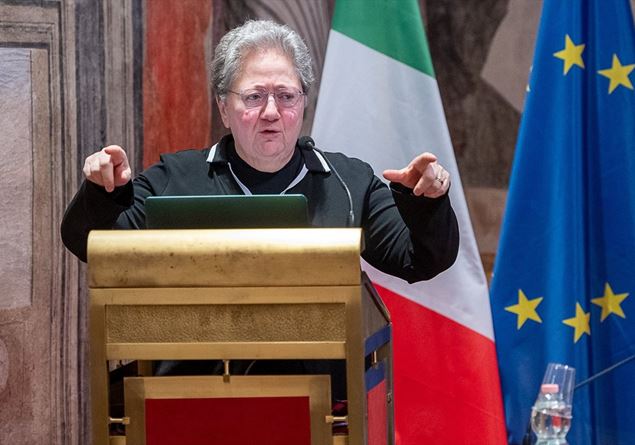The information on the life and martyrdom of Agnes is varied and sometimes conflicting, but has ancient references, first of all a poem engraved on her tombstone, composed by Pope Damasus, who died in 384, which reports an oral source. According to Damaso, Agnese faced the fire with courage and by covering her naked body with her hair.
The intrepid courage of Agnes, very young yet mature in faith, is exalted by Saint Ambrose in De virginibusin the hymn Agnes beatae virginis and in the letter to Simpliciano where he unites her with Thecla and Pelagia, who went to martyrdom as if to a party. Ambrose, based on oral traditions, speaks of the compulsion to worship pagans, and of a tyrant who wanted her as his wife. Agnes preferred martyrdom, and was pierced with the sword.
The Spanish Christian poet Prudentius celebrates Agnes in the 14th hymn of Peristephanon (405) introducing a new element: the compulsion to be exposed in a brothel. The customers did not dare to look at it, except for a young man, who was unable to possess it due to a flash of lightning thrown by an angel that blinded him. Death, according to Prudentius, occurred by decapitation.
Then they exist two Passions (tales of martyrdom): one, Latin from the 5th century, which was probably proclaimed on the feast of Agnes, and according to which the executioner was the prefect of Rome, father of the rejected suitor: here the forced undressing, the gesture of covering herself and Agnes’s initiation into the brothel. In the Greek Passio, also from the 5th century, Agnes is instead an adult woman who introduces Christ to many matrons. Reported, she was exposed in the brothel, from which however she emerged unharmed, and later martyred.
Collating the sources some data emerges: Agnes, from a Roman and Christian family – perhaps patrician, but according to some, the daughter of freedmen – consecrated herself to God at a very young age; at twelve years old, during the persecutions of Diocletian, while many Christians renounced, he maintained his loyalty to Christ. The son of the prefect of Rome, fallen in love with her and rejected, reported her to the authorities; perhaps the prefect himself had her exposed naked in a place for public prostitutes in the Agonale circus, today the crypt of Sant’Agnese in Piazza Navona. She was thrown into the fire, but the flames split without touching her, while her hair grew to the point of covering her naked body.
She was finally pierced with a sword blow to the throat, just as lambs were killed. This is also why in iconography she is often depicted with a lamb, a symbol of candor and sacrifice. The martyrdom has been placed by some between 249 and 251 during the persecution decreed by the emperor Decius, others place it in 304, during the last great persecution, wanted by Diocletian. After his death, his body was buried in the catacombs along the Via Nomentana, today known by his name. Here Princess Constantine, daughter of Constantine, had a collegiate church built with her own mausoleum.
Pope Honorius I, in the 7th century, then built a grandiose basilica with a double row of columns, an object of admiration, embellished among other things with a cycle of frescoes narrating the passio (lost in subsequent alterations). The basilica was embellished several times between the sixteenth and eighteenth centuries and renovated by Pius IX in the mid-nineteenth century.
the tradition of little lambs
The cult of Saint Agnes was already present in Rome in the first half of the 4th century, centered on the young age of the martyr and on the example of fortitude given in a period in which Christianity suffered numerous defections. The very name of Agnese, which has a Greek root in the adjective haghnos = pure, chaste, is connected above all to the Latin term agnus (lamb) of biblical flavor, but also of symbolic reference: Agnes, who won by the blood of the Lamb, realized in herself the mystical wedding that the Lamb celebrates with the Church, his bride.
In Rome in the early 8th century there existed a monastery and oratory with the title of Sant’Agnese ad duo Furna, while the more famous church of Sant’Agnese in Piazza Navona, place of martyrdom, also mentioned in the mid-8th century, it was renewed and reconsecrated by Callixtus II in 1123, and then rebuilt in the seventeenth century.
In the 9th century the body of Saint Agnes, venerated in an ark in the crypt of the basilica on the Nomentana, was deprived of the head, transported to the Sancta Sanctorum of the Lateran Palace. On that occasion, the remains of Saint Emerenziana had to be united from the Maggiore cemetery, which Passio of Agnes he defines as a catechumen and her foster sister, stoned on the same day as the funeral of Saint Agnes.
The On 21 January 1621 the body of the saint was placed, together with the remains of Emerenziana, in a silver chest, under the main altar of the basilica in via Nomentana.
The illustrious relic of the head, which the medical examination of 1903 refers to a young girl of 11-12 years old, at the behest of Pius A reliquary is also mentioned, with an arm of the saint, in the sacristy of San Pietro in Vincoli.
The cult of Agnes was widespread already in the early Middle Ages, attested by the presence of churches dedicated to her and by the representation of her figure in the theories of martyrs and saintsthe. Agnes was celebrated, over the centuries, with cycles of frescoes and her martyrdom was often the subject of sacred representations. According to an ancient custom, in the Nomentana basilica, every year on January 21st, two lambs raised by nuns are blessed; with their wool the Benedictines of Santa Cecilia weave the sacred pallium, white stoles of the Catholic patriarchs and metropolitans, which are blessed by the Pope on the evening of June 28th on the tomb of Saint Peter.
Agnes, patron saint of young people, is the protector of chastity, gardeners and greengrocers. She is also patron of the Order of the Trinitarians: in fact on 28 January 1193, the octave of the martyrdom of Saint Agnes (when according to tradition her parents went to her tomb and Agnes appeared to them with a lamb in her arms, symbol of Christ), Saint John de Matha had the vision of Christ in the gesture of exchanging Christian and Muslim slaves and the consequent inspiration to found an order that exercised the ransom of prisoners. Agnese is also patroness of the Visconti family, lords of Milan.










